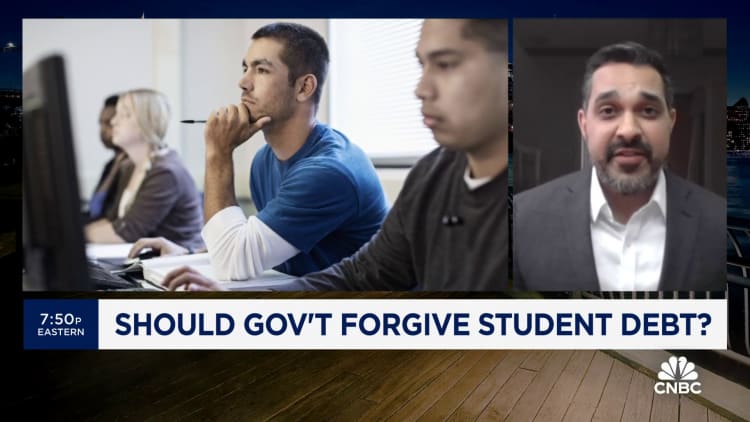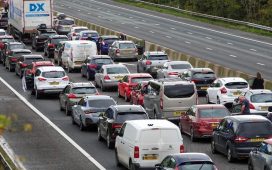Female firefighter putting on her protective equipment inside the fire station in response to an emergency
Trevor Williams | Digitalvision | Getty Images
The Biden administration’s latest student loan forgiveness announcement contained good news for more people than the 77,700 borrowers eligible for this round of aid.
Starting next week, the administration said, President Joe Biden will send an email to nearly 380,000 additional borrowers confirming that they are “on track” for loan cancellation within two years as long as they continue to meet the requirements of the Public Service Loan Forgiveness program.
“I’ve heard from countless people who have told me that relieving the burden of their student loan debt will allow them to support themselves and their families, buy their first home, start a small business, and move forward with life plans they’ve put on hold,” Biden’s email says, in a draft reviewed by CNBC.
More from Personal Finance:
Why gas is so expensive in California
Credit card users face ‘consequences’ from falling behind
After Biden praises progress on inflation, economists weigh in
The Supreme Court last June struck down the president’s plan to deliver student loan forgiveness to as many as 40 million Americans. Since then, his administration has tried to cancel the debt in various other ways, using its existing authority. It has mainly done so by overhauling existing loan relief programs that historically were hard to access.
As a result, since Biden was elected, his administration has so far cleared the education debts of nearly 4 million people, totaling $143.6 billion in relief.
Those who haven’t qualified for that aid are likely wondering, “When will my turn come?”
While Biden’s emails may answer that question for some, here are other ways borrowers can figure out if, and when, they may be eligible for debt cancellation.
“These forgiveness opportunities are fantastic, but they are complicated,” said Elaine Rubin, director of corporate communications at Edvisors, which helps students navigate college costs and borrowing.
‘Over 100’ student loan forgiveness programs
If you’re not enrolled in a program that leads to student loan forgiveness, you can find “great information” on the U.S. Department of Education’s website, Studentaid.gov, about the different opportunities, said Betsy Mayotte, president of The Institute of Student Loan Advisors, a nonprofit.
Mayotte said students should “read all the things. They can also contact their loan servicer to talk about their potential eligibility and steps they may have to take to qualify.”
Two of the most popular debt cancellation avenues are the Public Service Loan Forgiveness program, which leads to a debt jubilee after a decade of payments for qualifying workers, and the income-driven repayment plans. Those plans, which cap a borrowers’ monthly bill at a share of their discretionary income, lead to debt erasure after 10 to 25 years of payments. There are currently four different plans, each with different rules.
Much of the relief the Biden administration has delivered so far has been through fixes to these two programs.

But there are also “over 100 other forgiveness programs out there to explore,” Mayotte said.
“Many are offered by states looking to encourage certain types of employment, such as health care and public defenders,” she said.
Mayotte’s website, FreeStudentLoanAdvice.org, has a database of these programs, she said.
Meanwhile, after the Supreme Court blocked Biden’s sweeping student loan forgiveness plan, his administration began working on a revised relief plan. The administration could roll out that “Plan B” program before November, and as many as 10 million people could benefit, according to one estimate.
Track qualifying payments, required steps
The loan forgiveness programs can be confusing and many borrowers have run into walls trying to access the relief to which they’re entitled. Given those difficulties, once you know the student loan forgiveness plan you’re pursuing, experts recommend keeping a record of the requirements you’ve met along the way.
For example, borrowers in the Public Service Loan Forgiveness program are required to make 120 qualifying payments. They should be able to get a history of their payments at StudentAid.gov by looking into their loan details, Mayotte said. They can also ask their servicer for a complete history.
There have also been many policy updates of late for borrowers, almost all of which are positive.
“The changes implemented under the Biden administration will get borrowers closer to forgiveness,” Rubin said. “Especially borrowers who have been in repayment for some time.”
The Education Department has been reviewing the accounts of borrowers in income-driven repayment plans, and in some cases giving people credit on their forgiveness timeline for periods that didn’t qualify previously. For example, some past deferments or forbearances may now count.
If a borrower has multiple loans, meanwhile, they can apply for consolidation — which combines federal student loans into one new loan — and get credit going back as far as their first loan payment on the oldest of their original loans in that bundle. The deadline for consolidating and getting credit under the income-driven repayment plan recount is April 30.
If a borrower believes there is an issue with their payment count, they can talk to their loan servicer or submit a complaint with the Department of Education’s Federal Student Aid unit, Rubin said.











